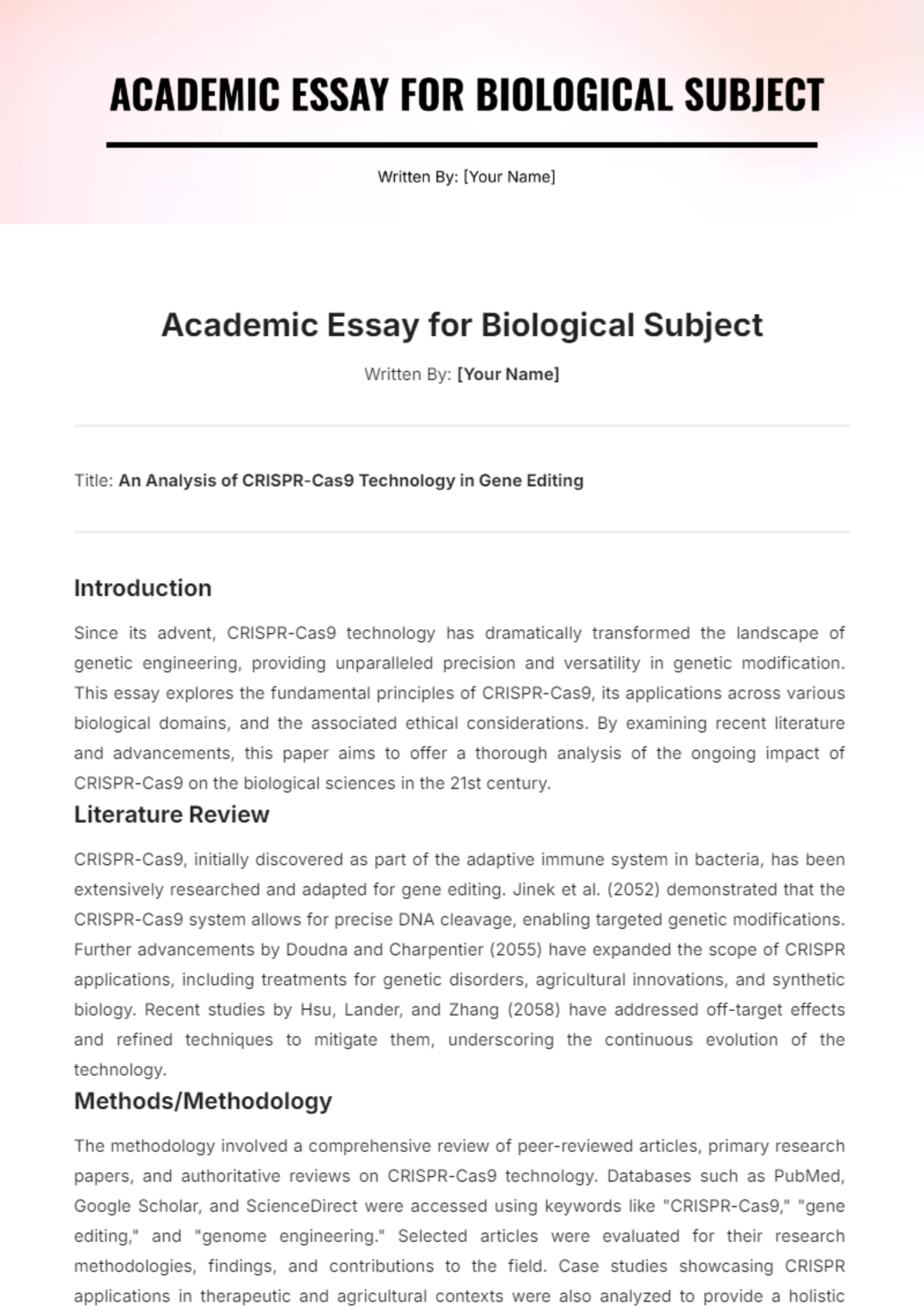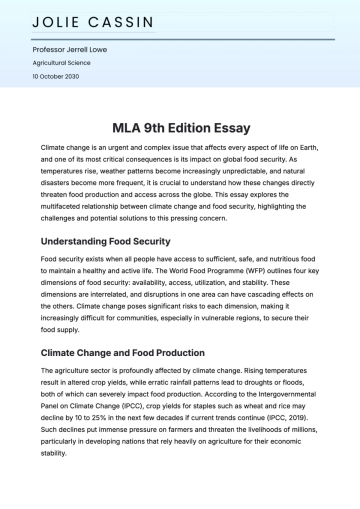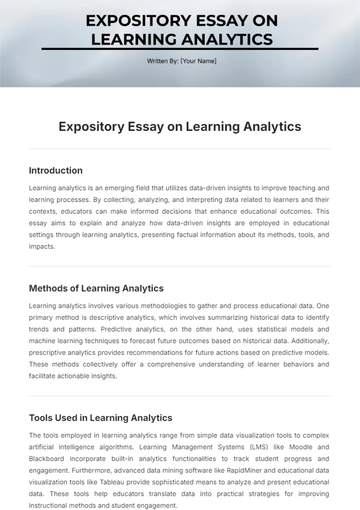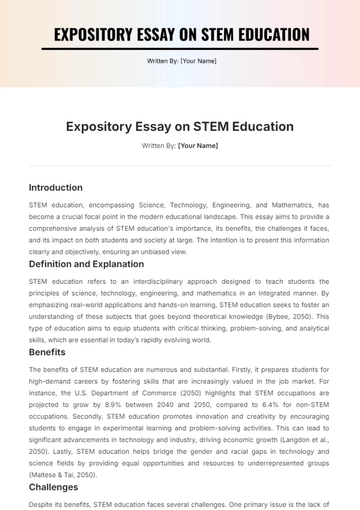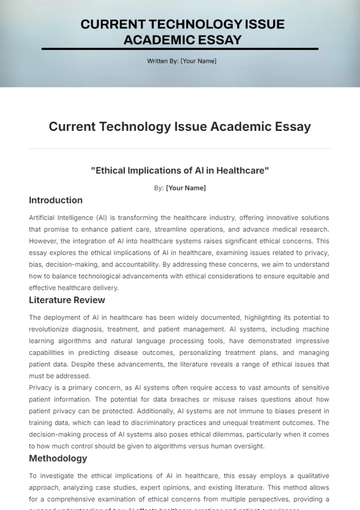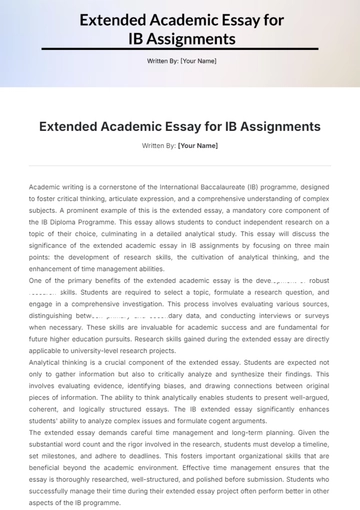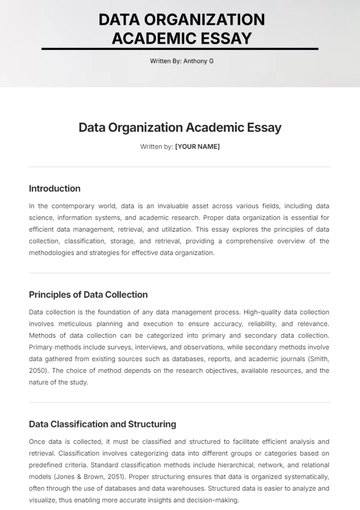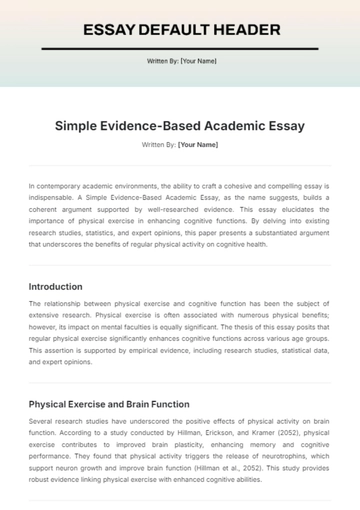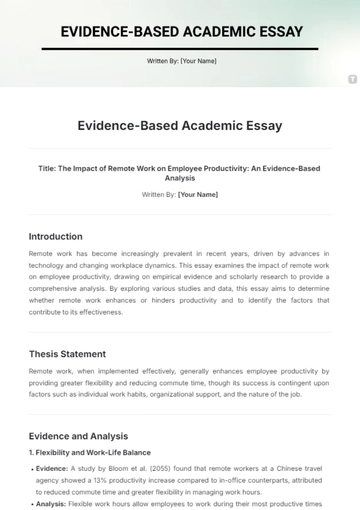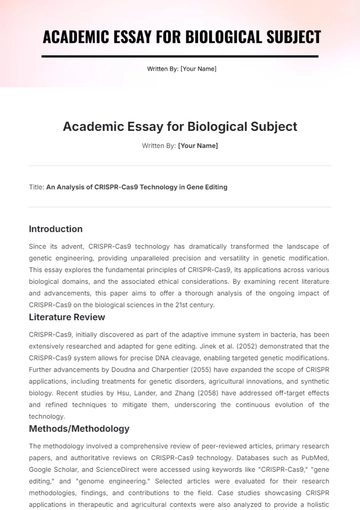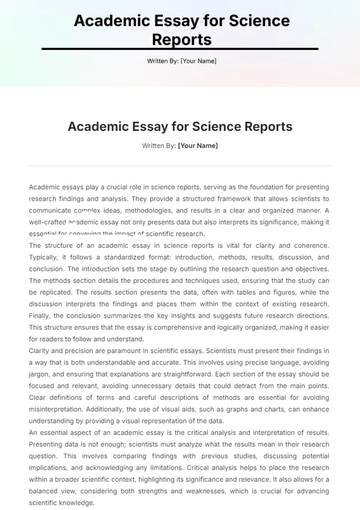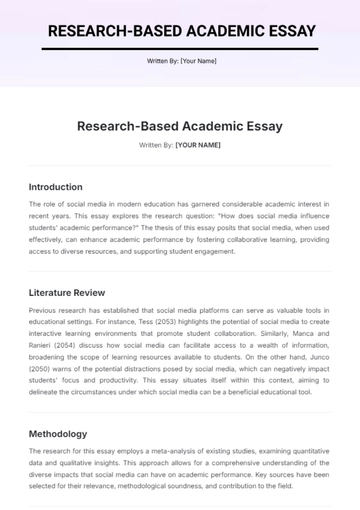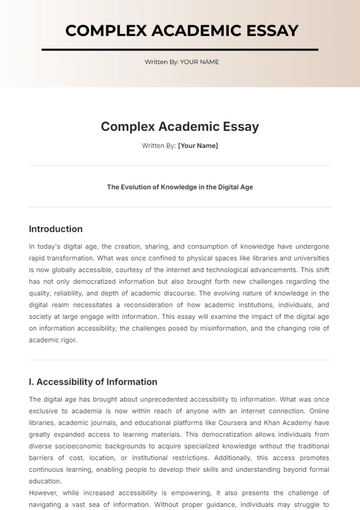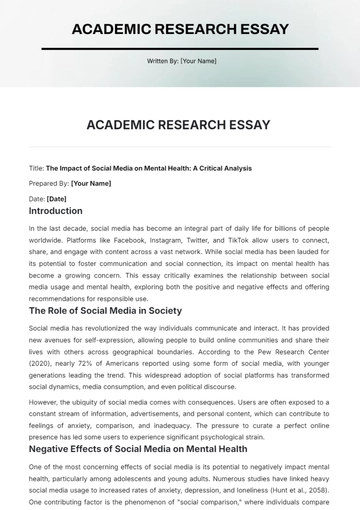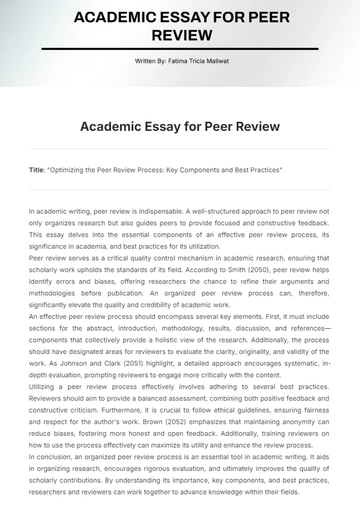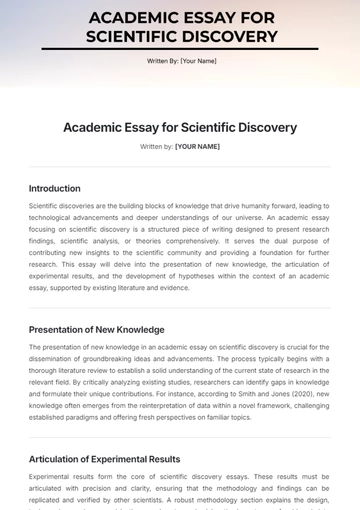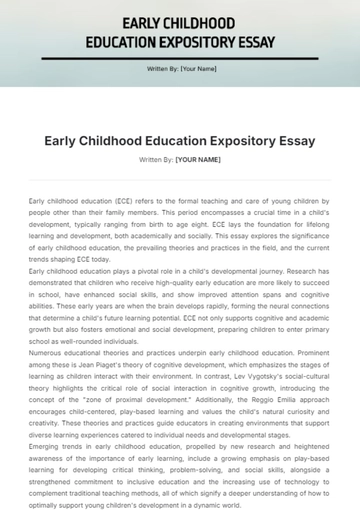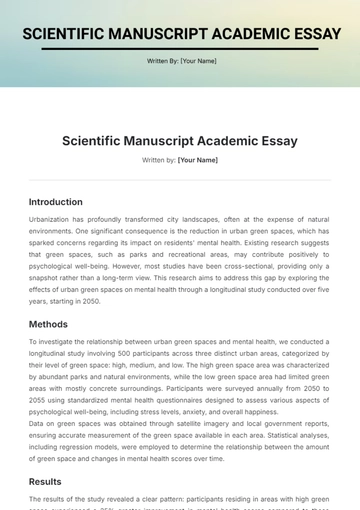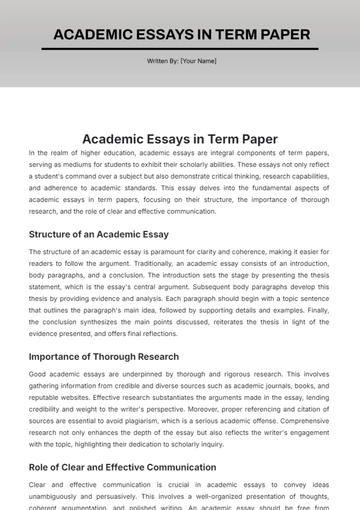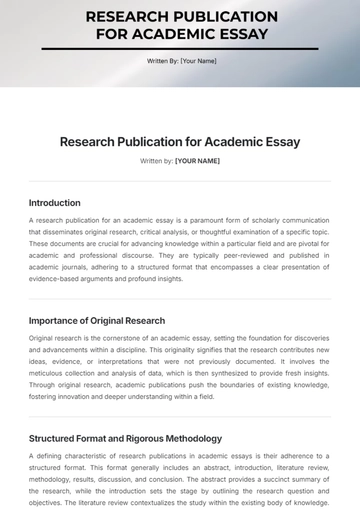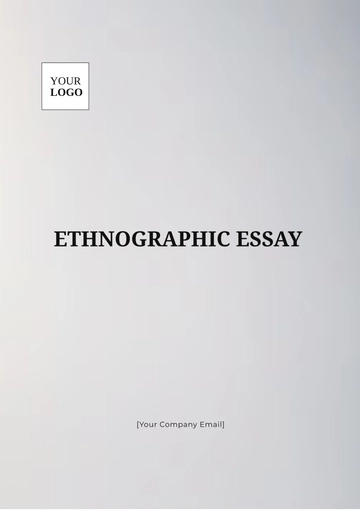Academic Essay for Biological Subject
Written By: [Your Name]
Title: An Analysis of CRISPR-Cas9 Technology in Gene Editing
Introduction
Since its advent, CRISPR-Cas9 technology has dramatically transformed the landscape of genetic engineering, providing unparalleled precision and versatility in genetic modification. This essay explores the fundamental principles of CRISPR-Cas9, its applications across various biological domains, and the associated ethical considerations. By examining recent literature and advancements, this paper aims to offer a thorough analysis of the ongoing impact of CRISPR-Cas9 on the biological sciences in the 21st century.
Literature Review
CRISPR-Cas9, initially discovered as part of the adaptive immune system in bacteria, has been extensively researched and adapted for gene editing. Jinek et al. (2052) demonstrated that the CRISPR-Cas9 system allows for precise DNA cleavage, enabling targeted genetic modifications. Further advancements by Doudna and Charpentier (2055) have expanded the scope of CRISPR applications, including treatments for genetic disorders, agricultural innovations, and synthetic biology. Recent studies by Hsu, Lander, and Zhang (2058) have addressed off-target effects and refined techniques to mitigate them, underscoring the continuous evolution of the technology.
Methods/Methodology
The methodology involved a comprehensive review of peer-reviewed articles, primary research papers, and authoritative reviews on CRISPR-Cas9 technology. Databases such as PubMed, Google Scholar, and ScienceDirect were accessed using keywords like "CRISPR-Cas9," "gene editing," and "genome engineering." Selected articles were evaluated for their research methodologies, findings, and contributions to the field. Case studies showcasing CRISPR applications in therapeutic and agricultural contexts were also analyzed to provide a holistic view of the technology's impact.
Results
CRISPR-Cas9 has demonstrated significant efficacy in gene editing across diverse organisms, from bacteria to humans. Research by Yin et al. (2054) highlighted successful gene correction in mouse models of hereditary diseases, showcasing the system's therapeutic potential. In agriculture, Zhang et al. (2059) reported enhanced crop resistance to diseases and improved yields, illustrating CRISPR's role in advancing food security. Despite these advancements, challenges related to off-target effects and ethical considerations remain crucial issues that need addressing.
Discussion
The discussion surrounding CRISPR-Cas9 technology encompasses its transformative impact on biological research and practical applications. The precision of gene editing opens up new possibilities for curing genetic disorders, developing resilient crops, and advancing synthetic biology. However, concerns about unintended genetic modifications and the ethical implications of technologies such as germline editing and genetically modified organisms (GMOs) remain prominent. As O'Keefe et al. (2056) emphasize, navigating these ethical and societal challenges is essential for the responsible use of CRISPR technology.
Conclusion
In conclusion, CRISPR-Cas9 represents a milestone in gene editing technology, offering exceptional precision and a wide range of applications. While the technology holds great promise for advancing medical, agricultural, and synthetic biological fields, it also requires careful consideration of ethical and safety concerns. Ongoing research and informed dialogue will be crucial in maximizing the potential of CRISPR-Cas9 while ensuring its responsible implementation.
References/Bibliography
Jinek, M., Chylinski, K., Fonfara, I., Hauer, M., Doudna, J. A., & Charpentier, E. (2052). A programmable dual-–RNA–guided DNA endonuclease in adaptive bacterial immunity. Science, 377(6096), 816-821.
Doudna, J. A., & Charpentier, E. (2055). The new frontier of genome engineering with CRISPR-Cas9. Science, 356(6213), 1258096.
Hsu, P. D., Lander, E. S., & Zhang, F. (2058). Development and applications of CRISPR-Cas9 for genome engineering. Cell, 167(6), 1262-1278.
Yin, H., Xue, W., Chen, S., Bogorad, R. L., Benedetti, E., Grompe, M., ... & Anderson, D. G. (2054). Genome editing with Cas9 in adult mice corrects a disease mutation and phenotype. Nature Biotechnology, 34(6), 551-553.
Zhang, H., Zhang, J., Wei, P., Zhang, B., Gou, F., Feng, Z., ... & Bao, Y. (2059). The CRISPR/Cas9 system produces specific and efficient genome editing in plants. Nature Biotechnology, 37(8), 688-691.
O’Keefe, M., Perrault, S., Halpern, J., Ikemoto, L., Yarborough, M., & UC North Bioethics Collaboratory for Life & Health Sciences. (2056). CRISPR-Cas9 and the ethics of gene editing. The Hastings Center Report, 50(5), 32-39.
Essay Templates @ Template.net
